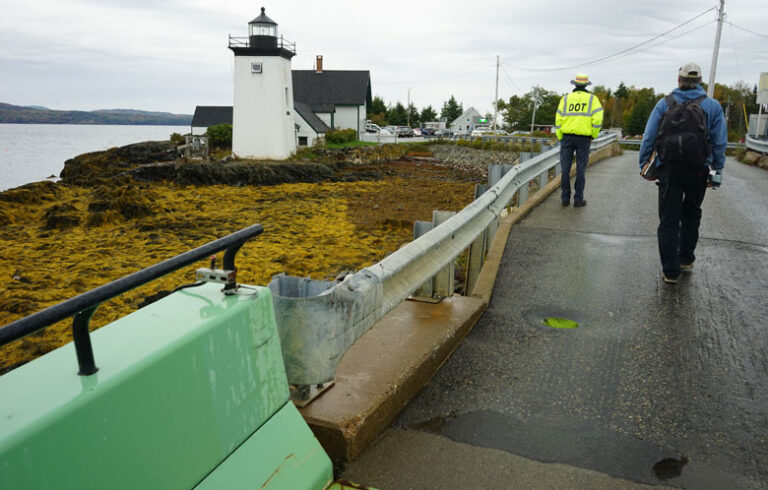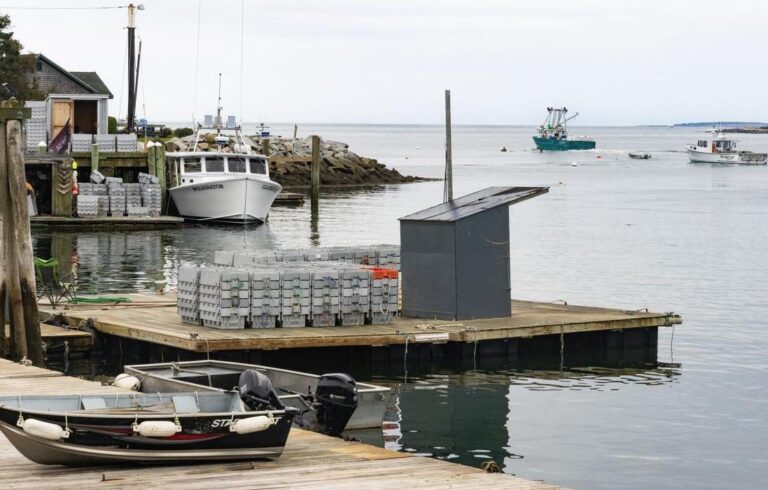When Frank and Denie Weil first visited Stonington by sailboat in the mid-1960s, they fell in love with the place and were particularly fascinated by the granite quarries on nearby Crotch Island.
As the decades passed, the Weils watched as the remnants of those once-booming quarries—the derricks, the power plant buildings and drafting offices, the steam-generating boiler, and the railroad system—disappeared through a combination of decay and purposeful dismantling.
Moved to share the community’s granite history with visitors and future generations, they created the nonprofit Deer Isle Granite Museum. In the summer of 1996, they opened the museum in the Webb Building, a former general store on Main Street that the Weils own.
Now in their early 90s, the Weils are handing over the reins of the museum to a new generation. Last summer, the museum created an expanded board of directors that places its future firmly in the hands of Stonington residents.
“They understood that in order for this to be a local institution and less a ‘Denie and Frank’ thing, that eventually they would have to hand control of the museum to a group of locals,” said the Weils’ son, William, who is the only member of the family (and a seasonal Stonington resident) on the newly-expanded board of directors.

In addition to William Weil, board members are Sally Richardson, who has been involved with the granite museum since its earliest days; Linda Nelson, Stonington’s economic and community development director; and Kathleen Billings, Stonington’s town manager.
While two town employees are on the new board of directors, that does not mean the town is now responsible for the museum, Nelson said.
“The fact that we’re on the board does not mean that the town is taking this over, or funding this, or anything like that,” she said. “It’s still an independent 501(c)(3) and we just happen to be new board members.”
The new board of directors has many ideas about the future of the museum, said William Weil, but they aren’t ready to announce those just yet. They will say, however, that they want to get the museum’s star attraction—a large model of a quarry circa 1900 on Crotch Island—repaired so that it’s fully operational again; refresh the exhibits every year; and have the museum open more often—it was only open three days a week last summer.
What won’t change is the commitment to celebrating Stonington’s history, said Nelson.
“I really think it’s about how do we keep our heritage alive, and how not only do we keep it alive for our local year-round residents, but how do we really advance cultural heritage tourism, which is much more sustainable than ordinary tourism, and really use the assets we have and strengthen existing assets in order to do that.”

If you don’t live in or near Stonington, you may be surprised to learn that the community that is today known for its fishing industry (for five years running, from 2017 to 2021, Stonington was the most lucrative fishing port in Maine, coming in at a whopping $73.27 million last year) was once a granite-producing powerhouse.
While fishing has always been an important industry in Stonington, from the mid-1800s to the first decades of the 20th century, granite was king. The granite quarries of Stonington (so named because of those quarries) and its surrounds, including Crotch Island, were prized for producing high-quality granite, and particularly for two types of granite that were pinkish in color, called “Sherwood pink” and “Goss pink.”
In the days before glass, steel, and concrete became the primary fabrics of construction, Stonington granite was used in many ordinary and not-so-ordinary building projects, such as the approaches to the Brooklyn Bridge; the Museum of Fine Arts, Boston; the 20-foot, 8-inch bowl of the Oceanus Fountain at the Rockefeller family’s Kykuit estate in New York’s Hudson Valley; Sing Sing Prison; the Cathedral of St. John the Divine in Manhattan; and the John F. Kennedy Memorial at Arlington National Cemetery.
The granite boom times were long over by the time Frank and Deni Weil sailed into Stonington in the mid-1960s. Today, one quarry on Crotch Island is in operation. Run by New England Stone Industries/Granites of America of Smithfield, R.I., the quarry supplies Maine granite for projects big and small. Two recent projects include the Art of the Americas Wing of the Museum of Fine Arts, Boston, which opened in 2010 and the Philadelphia Temple of the Church of Jesus Christ of Latter-day Saints, dedicated in 2016.

While the granite industry in Stonington today is a shadow of its heyday, its heritage is critical to the community now as it faces likely upheaval in its fishing industry, said Nelson.
“We were able to transition from granite to fishing, so if we have to transition in the future, it’s not like we don’t have the resilience and the capacity in this community to make those big changes because we’ve done it,” she said. “I think that’s why history is important and why telling these stories and thinking about what our cultural heritage is, is important because it gives people possible new ways to think about change.”
To learn more about the Deer Isle Granite Museum, go to https://deerislegranitemuseum.wordpress.com/.
Watch the museum’s video about Stonington’s granite history at https://youtu.be/qFVrYqBh-no.
To learn more about the granite industry on Deer Isle, read Denie Weil’s book, Stone Slabs and Iron Men: The Deer Isle Granite Industry.





